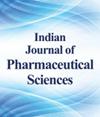曲安奈德联合复方倍他米松治疗瘢痕疙瘩的不良反应及疗效评价
IF 0.4
4区 医学
Q4 PHARMACOLOGY & PHARMACY
Indian Journal of Pharmaceutical Sciences
Pub Date : 2023-01-01
DOI:10.36468/pharmaceutical-sciences.spl.689
引用次数: 0
摘要
Zhang等:曲安奈德联合复方倍他米松治疗瘢痕疙瘩的疗效探讨曲安奈德联合复方倍他米松治疗瘢痕疙瘩的疗效及不良反应是本研究的目的。100例患者随机分为研究组和对照组(每组50例)。研究组采用曲安奈德注射液联合复方倍他米松注射液序贯治疗,对照组采用复方倍他米松注射液。两组均治疗3个疗程,每个疗程持续3w。比较两组温哥华疤痕评分、治疗效果及不良反应,并在用药结束后随访1 y复发率。治疗前,两组温哥华疤痕评分差异无统计学意义,治疗后,研究组优于对照组(p<0.05)。研究组总有效率(82%)高于对照组(54%,p<0.05)。研究组药物不良反应总发生率为8%,对照组为6%,两组比较无统计学意义。研究组和对照组在停药6个月后复发率分别为28%和34%,停药12个月后复发率分别为32%和42%,两组比较差异有统计学意义。序贯注射曲安奈德联合复方倍他米松治疗瘢痕疙瘩有效,安全性高,复发率低,值得临床推荐。本文章由计算机程序翻译,如有差异,请以英文原文为准。
Evaluation of Adverse Reactions and Effects of Triamcinolone Acetonide Combined with Compound Betamethasone in Keloid
Zhang et al. : Effects of Triamcinolone Acetonide Combined with Compound Betamethasone in Keloid To explore the drug effect and adverse reaction of triamcinolone acetonide combined with compound betamethasone in keloid is the objective of the study. 100 patients were randomly divided into study group and control group (50 patients in each group). The research group received sequential treatment with triamcinolone acetonide injection combined with compound betamethasone injection and the control group received compound betamethasone injection. Both groups had 3 courses of treatment and each course of treatment lasted for 3 w. The Vancouver scar scale score, treatment effect and adverse reactions were compared between the two groups and the recurrence rate was followed up for 1 y after the end of medication. Before treatment, there was no significant difference in Vancouver scar scale scores between the two groups but after medication, the study group was better than that of the control group (p<0.05). The total effective rate of the study group (82 %) was higher than that of the control group (54 %, p<0.05). The total incidence of adverse drug reactions in the study group was 8 % while in the control group it was 6 % and the comparison between the two groups was not statistically significant. The recurrence rates of the study group and the control group were 28 % and 34 % 6 mo after the end of medication and 32 % and 42 % after 12 mo. There was a significant difference between the two groups. The sequential injection of triamcinolone acetonide combined with compound betamethasone is effective in the treatment of keloids, with high safety and low recurrence rate, which is worthy of clinical recommendation.
求助全文
通过发布文献求助,成功后即可免费获取论文全文。
去求助
来源期刊

Indian Journal of Pharmaceutical Sciences
PHARMACOLOGY & PHARMACY-
自引率
0.00%
发文量
0
审稿时长
2 months
期刊介绍:
The Indian Journal of Pharmaceutical Sciences (IJPS) is a bi-monthly Journal, which publishes original research work that contributes significantly to further the scientific knowledge in Pharmaceutical Sciences (Pharmaceutical Technology, Pharmaceutics, Biopharmaceutics, Pharmacokinetics, Pharmaceutical/Medicinal Chemistry, Computational Chemistry and Molecular Drug Design, Pharmacognosy and Phytochemistry, Pharmacology and Therapeutics, Pharmaceutical Analysis, Pharmacy Practice, Clinical and Hospital Pharmacy, Pharmacovigilance, Pharmacoepidemiology, Pharmacoeconomics, Drug Information, Patient Counselling, Adverse Drug Reactions Monitoring, Medication Errors, Medication Optimization, Medication Therapy Management, Cell Biology, Genomics and Proteomics, Pharmacogenomics, Bioinformatics and Biotechnology of Pharmaceutical Interest). The Journal publishes original research work either as a Full Research Paper or as a Short Communication. Review Articles on current topics in Pharmaceutical Sciences are also considered for publication by the Journal.
 求助内容:
求助内容: 应助结果提醒方式:
应助结果提醒方式:


